Table of contents
- Background test bench measurements for motorcycle tests This is how performance measurement works
- Rear wheel performance
- Power on the crankshaft
- Road tires instead of rough ones
- Do you fancy formulas and equations? Here you go!
- Measured and calculated values
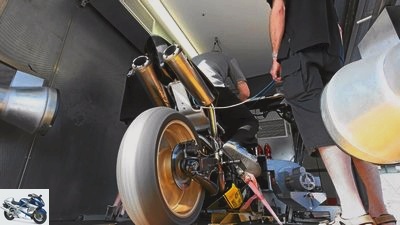
markus-jahn.com
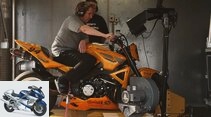

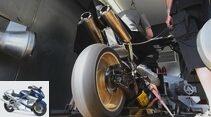

9 pictures
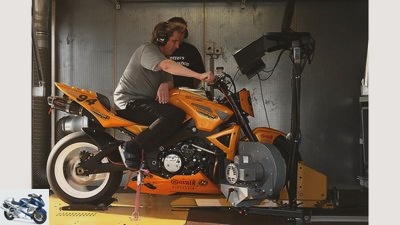
markus-jahn.com
1/9
Every test machine has to go through this: whether like here with the PS-TunerGP or on the editorial test bench, performance measurement is mandatory.
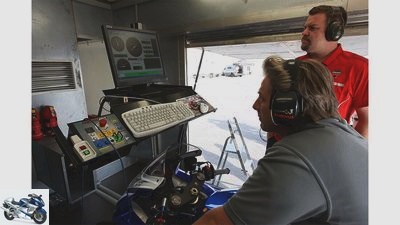
markus-jahn.com
2/9
… Nothing works here without hearing protection.
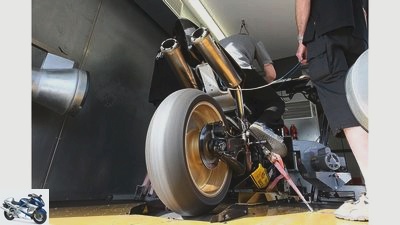
markus-jahn.com
3/9
Deafening noise: the drive roars, the fresh air blowers whistle, the suction device roars …
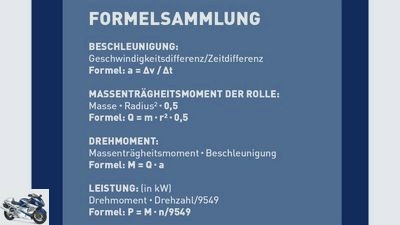
MOTORCYCLE
4/9
Small formula collection.
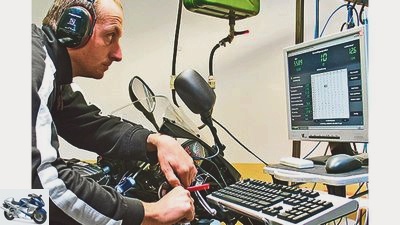
archive
5/9
Developing mappings means a lot of test bench work. Especially useful for tuned bikes.
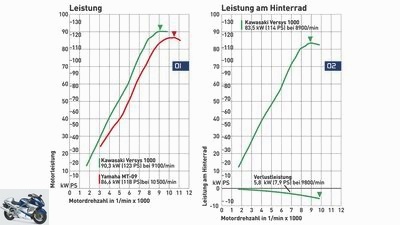
MOTORCYCLE
6/9
As standard diagrams we usually show the power on the crankshaft (diagram 01) and the torque (03). The lower curve in diagram 02 shows the power loss. It is added to the upper curve (rear wheel power).
For this particular comparison, we superimposed the curves of the Kawasaki Versys 1000 (green) and the Yamaha MT-09 (red). Both machines have a similar peak performance, but differ significantly in terms of displacement. They also play in a different weight league.

MOTORCYCLE
7/9
In diagrams 01 and 03 you can clearly see the motor superiority of the Kawasaki up to the maximum output. With a displacement excess of over 23 percent (1043 to 847 cubic), this is not a big surprise.
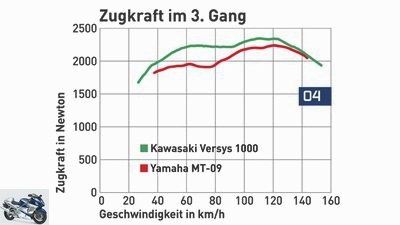
MOTORCYCLE
8/9
In terms of tractive power in third gear (04), the green one is still ahead, but it is already closer. The pulling force is the force that acts on the rear wheel. In contrast to the conventional diagrams, the total gear ratio (primary, secondary and gear ratio) is included in the tensile force. The Yamaha has a slightly shorter translation than the Kawasaki.
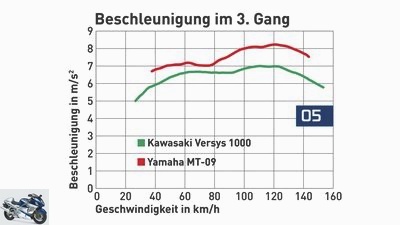
MOTORCYCLE
9/9
Diagram 05 shows the acceleration. A purely arithmetical value without driving resistance (rolling and air resistance). This value also takes the vehicle weight into account and stands for the dynamics that the driver feels. Lo and behold: suddenly the MT-09 is ahead. At 192 kilos, the Yam is a whopping 63 kilos lighter than the Versys (255 kilos).
counselor
workshop
Performance measurement test bench for motorcycle tests
Background test bench measurements for motorcycle tests
This is how performance measurement works
Content of
Clamp the bike on the test stand roller, turn the tap to the stop, is the power measurement finished? Determining the power and torque of motorcycles is not that easy.
Volkmar Jacob
05/12/2015
Deafening noise pervades the room. The drive roars its soul from the engine block, and the two fresh air blowers whistle in the highest tones. In addition, the exhaust device for the exhaust roars. Nothing works here without hearing protection. We are on our test bench, where every test machine goes through the same procedure: determining power and torque. These values appear regularly in the booklet as curves in a diagram. But how exactly does the performance measurement work??
Buy complete article
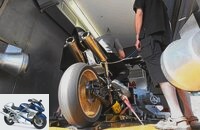
Background test bench measurements for motorcycle tests
This is how performance measurement works
4 pages) as PDF
€ 2.00
Buy now
Rear wheel performance
In simple terms, the system measures how fast a roller driven by the rear wheel accelerates. To do this, it records the time in which the roller builds up which speed. From the acceleration, the computer calculates the torque and, from this, the rear wheel power, taking into account the mass moment of inertia of the roller. If you want to know exactly how this works, read the last section. So that the computer also spits out how much power is present at which speed, the tester taps the ignition or speed signal on the bike. When measuring, we always chase the motors into the limiter in order to record the maximum speed.
Power on the crankshaft
But how do you get from it to power on the crankshaft? The manufacturers indicate this (higher) value in their data, and we show it in the diagrams. The crankshaft power cannot be measured, only calculated. It takes two steps to do this. First, the test bench determines what is known as the loss or frictional power. It arises in the drive train between the crankshaft and the rear wheel. It includes the secondary drive (pinion, chain, sprocket), the gearbox and the clutch. Tires also cost performance – very soft more, very hard less. The test bench calculates the power loss as soon as the disengaged motorcycle is allowed to coast for a while. This value is added to the rear wheel power, and you already know the power at the clutch. Now pack just two percent of this value on top, and the crankshaft power is ready. Example: A machine has 200 HP on the clutch. 204 HP are then applied to the crankshaft.
Road tires instead of rough ones
Why? In most engines there is a transmission between the clutch and the crankshaft – another performance hog. An EU directive puts this loss of performance at two percent.
In order to keep the power loss as low as possible, the testers always pay attention to a well-lubricated chain, correct sag and the right tire pressure (approx. 2.5 bar). Coarse tires (sport enduro, crosser) are being replaced by road tires.
Do you fancy formulas and equations? Here you go!
If you have made it this far, you will surely appreciate a few formulas and equations. Loyal readers may recall that we plowed this subject a few years ago. Here again some expertise to freshen up.
As mentioned at the beginning, the test stand records the acceleration of the roll. For this he needs two values: firstly the speed difference of the individual measurements (∆v, pronounced: Delta-Vau) and secondly their time difference (∆t, pronounced Delta-Te). The acceleration (symbol: a) is calculated as follows: a = ∆v / ∆t. Example: If the roller increases its rotation speed every second by four revolutions / second (in the first second it rotates four times, in the second eight times, in the third twelve times, etc.), this results in an acceleration of 4 / s². However, acceleration alone does not get us any further, we also need the mass moment of inertia (symbol: Q) of the test stand roller. To put it roughly, this physical quantity expresses how much a rigid body defends itself from being set into rotation or being braked from such a rotation. The mass moment of inertia is calculated from the mass (m) of the roller and its radius (r). The following formula applies: Q = m • r² • 0.5. Example: A roll weighing 1000 kilograms has a diameter of 46 centimeters (corresponds to a radius of 23 centimeters, = 0.23 meters). The mass moment of inertia Q is 1000 kg • (0.23 m) ² • 0.5 = 26.45 kg m².
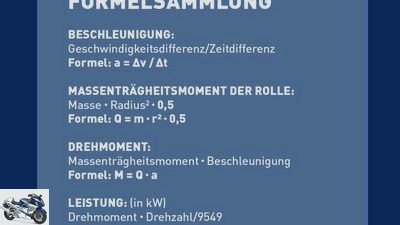
MOTORCYCLE
Small collection of formulas for determining performance.
The test bench computer uses this value to calculate the torque (symbol: M) with which the roller with the mass moment of inertia Q is accelerated by the amount a. The following applies: M = Q • a. For our example this means:
M = 26.45 kg m² • 4 / s² = 105.8 kg m² / s². The unit for force (Newton, N) can also be written as kg m / s². Therefore: 105.8 kg m² / s² correspond exactly to 105.8 Newton meters (Nm).
From this we can immediately calculate the kW output (symbol: P) at a certain speed (symbol: n). All we need is a constant that converts from revolutions per minute to meters per second. This constant is 60000 / 2π, i.e. approximately 9549. π describes the ratio of the circumference to the diameter and is approximately 3.1415. The following applies: P = n • M / 9549. If the 105.8 Nm are applied at 4450 rpm, for example, the drive at this speed consequently produces 49.3 kW, which equates to 67.1 hp. As is well known, one kW equals 1.36 hp.
Measured and calculated values
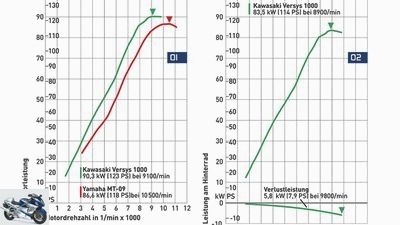
MOTORCYCLE
Here we show the diagrams for the power on the crankshaft as well as on the rear wheel.
As standard diagrams we usually show the power on the crankshaft (diagram 01) and the torque (03). For this particular comparison, we superimposed the curves of the Kawasaki Versys 1000 (green) and the Yamaha MT-09 (red). Both machines have a similar peak performance, but differ significantly in terms of displacement.
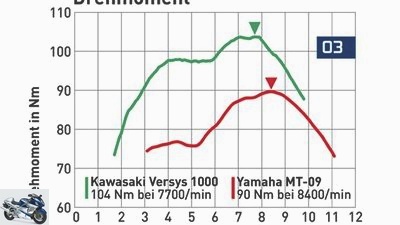
MOTORCYCLE
Diagram 3
They also play in a different weight league. In diagrams 01 and 03 you can clearly see the motor superiority of the Kawasaki up to the maximum output. With a displacement excess of over 23 percent (1043 to 847 cubic), this is not a big surprise.
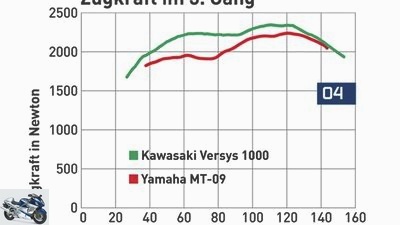
MOTORCYCLE
Diagram 4
In terms of tractive power in third gear (04), the green one is still ahead, but it is already closer. The pulling force is the force that acts on the rear wheel. In contrast to the conventional diagrams, the total gear ratio (primary, secondary and gear ratio) is included in the tensile force. The Yamaha has a slightly shorter translation than the Kawasaki.
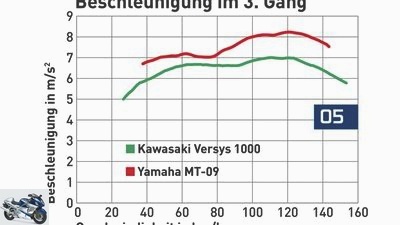
MOTORCYCLE
Diagram 5
Diagram 05 shows the acceleration. A purely arithmetical value without driving resistance (rolling and air resistance). This value also takes the vehicle weight into account and stands for the dynamics that the driver feels. Lo and behold: suddenly the MT-09 is ahead. At 192 kilos, the Yam is a whopping 63 kilos lighter than the Versys (255 kilos). The lower curve in diagram 02 shows the power loss. It is added to the upper curve (rear wheel power).
Related articles
-
Motorcycle anti-lock braking systems in a comparison test
Jahn 13th pictures Jahn 1/13 The relations shift on the wet test track – in the truest sense of the word. Jahn 2/13 In conclusion, it can be said that…
-
Honda NC 700 S in the test: the entry-level motorcycle from Honda
Artist 12th pictures Honda 1/12 Honda NC 700 S – The naked bike is powered by an in-line two-cylinder engine of 670 cubic meters. Honda 2/12 Honda NC 700…
-
Comparison test: 600cc extreme athlete
K motorcycles Comparison test: 600cc extreme athlete Comparison test: 600cc extreme athlete Spear tips Content of They flaunt long lances at the end, are…
-
Nine motorcycle cleaners in a comparison test
Photo: factstudio.de 21 pictures Klaus Herder 1/21 Our man in Winnenden: Karcher laboratory manager and GS driver Frank Ritscher (44) highly concentrated…
-
Motorcycle touring tires 120-70 ZR 17 and 180-55 ZR 17 in the test
Jahn 30th pictures Jahn 1/30 mps photo studio 2/30 Metzeler Roadtec Z8 Interact: MOTORRAD verdict: 6th place, 212 points. mps photo studio 3/30 Michelin…
-
Motorcycle tires for classic and youngtimers in the test dimensions 100-90-18 and 120-90-18
markus-jahn.com 22nd pictures markus-jahn.com 1/22 The tire test for classics and youngtimers was made with a 1991 Yamaha XJ 900 F.. markus-jahn.com 2/22…
-
Product test: motorcycle cleaner in the endurance test
Herder accesories Product test: motorcycle cleaner in the endurance test Product test Motorcycle cleaner in the endurance test His name is Ritscher….
-
Service test at the motorcycle dealer
mps photo studio 16 pictures mps photo studio 1/16 Everything was possible between 2400 and around 4300 euros. And in any case understandable, because…
-
Product test: motorcycle sat navs
manufacturer accesories Navis, communication, apps Product test: motorcycle sat navs Product test: motorcycle sat navs Motorcycle navigation devices in a…
-
Product test: motorcycle denim jackets
Lohse 17th pictures Lohse 1/17 Of course, there is only one thing that can realistically test whether the jeans clothes really hold up: a fall. Since no…